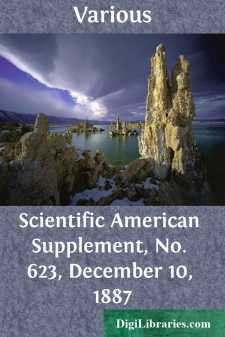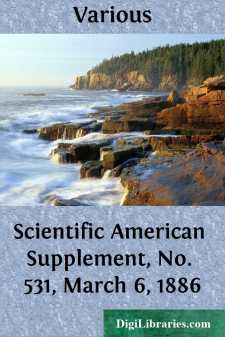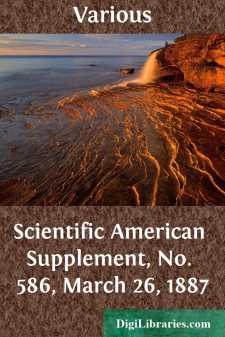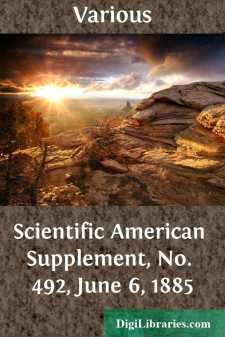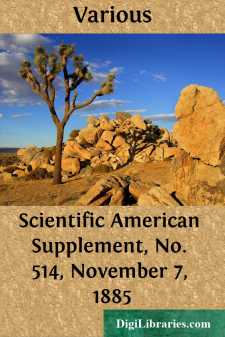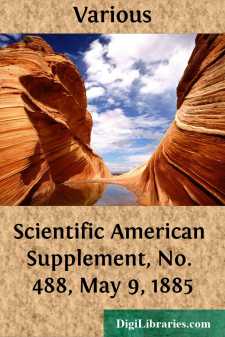Periodicals
- Art 27
- Children's periodicals 59
- Entertainment 5
- Food/Wine 2
- Games/Humor 455
- General 661
- Health 1
- History 53
- House/Home 1
- Regional 62
- Science/Nature
- Transportation 10
Science/Nature Books
Sort by:
by:
Various
The use of electricity in the reduction of metals from their ores is extending so rapidly, and the methods of its generation and application have been so greatly improved within a few years, that the possibility of its becoming the chief agent in the metallurgy of the future may now be admitted, even in cases where the present cost of treatment is too high to be commercially advantageous. The refining...
more...
by:
Various
The inauguration of the statue of Philip Lebon, the inventor of lighting by gas, occurred on the 26th of June, at Chaumont, under the auspices of the Technical Gas Society of France. The statue, which we illustrate herewith, is due to the practiced chisel of the young sculptor Antide Pechine, who has perfectly understood his work, and has represented the inventor at the moment at which he observes a...
more...
by:
Various
NOTE ON THE CONSTRUCTION OF A DISTILLERY CHIMNEY. FIG. 1—ELEVATION. At a recent meeting of the Industrial Society of Amiens, Mr. Schmidt, engineer of the Steam Users' Association, read a paper in which he described the process employed in the construction of a large chimney of peculiar character for the Rocourt distillery, at St. Quentin. This chimney, which is cylindrical in form, is 140 feet...
more...
by:
Various
THE USE OF IRON IN FORTIFICATION. Roumania is thinking of protecting a portion of the artillery of the forts surrounding her capital by metallic cupolas. But, before deciding upon the mode of constructing these formidable and costly affairs, and before ordering them, she has desired to ascertain their efficacy and the respective merits of the chilled iron armor which was recently in fashion and of...
more...
by:
Various
THE RETIRO VIADUCT. We give engravings of the viaduct over the river Retiro, Brazil, our illustrations being reproduced by permission from the Proceedings of the Institution of Civil Engineers. In a "selected paper" contributed to the volume of these proceedings just published, Mr. Jorge Rademaker Grunewald, Memb. Inst. C.E., describes the work as follows: VIADUCT OVER THE RETIRO, BRAZIL....
more...
by:
Various
BRISTOL CATHEDRAL. BRISTOL CATHEDRAL. An Augustinian monastery, founded by Robert Fitzhardinge in 1142, had its church, of Norman architecture, to which additions were made in the early English period. When Edmund Knowle was abbot, from 1306 to 1332, the Norman choir was replaced by that which now exists. His successor, Abbot Snow, built the chapels on the south side of the choir. Abbot Newland,...
more...
by:
Various
NEW SPANISH ARTILLERY. The Spanish Government is now engaged in supplying some of its principal fortifications with heavy guns of the most improved construction. The defenses of Cadiz and Ceuta have been greatly strengthened in this respect. The most recent additions are some very powerful Krupp guns for the fortress of Isabel II., at Mahon. NEW KRUPP BREECH LOADING GUNS FOR SPANISH FORTIFICATIONS....
more...
by:
Various
FOUNDATIONS IN QUICKSAND. Foundations in quicksand often have to be built in places where least expected, and sometimes the writer has been able to conveniently span the vein with an arch and avoid trouble; but where it cannot be conveniently arched over, it will be necessary to sheath pile for a trench and lay in broad sections of concrete until the space is crossed, the sheath piling being drawn and...
more...
by:
Various
ROMAN REMAINS AT LEICESTER, ENGLAND. The Roman tessellated pavement in Jewry Wall Street, Leicester, discovered in the year 1832, is well known to archaeologists; it has also been known as difficult of access, and hardly to be seen in a dark cellar, and, in fact, it has not been seen or visited, except by very few persons. Some time ago the Town Council resolved to purchase the house and premises, with...
more...
by:
Various
A VISIT TO THE CREUSOT WORKS. Here we are at the great forge (Fig. 1), that wonderful creation which has not its like in France, that gigantic construction which iron has wholly paid for, and which covers a space of twenty-four acres. We first remark two puddling halls, each of which contains 50 furnaces and 9 steam hammers. It is in these furnaces that the iron is puddled. The ball or bloom thus...
more...




